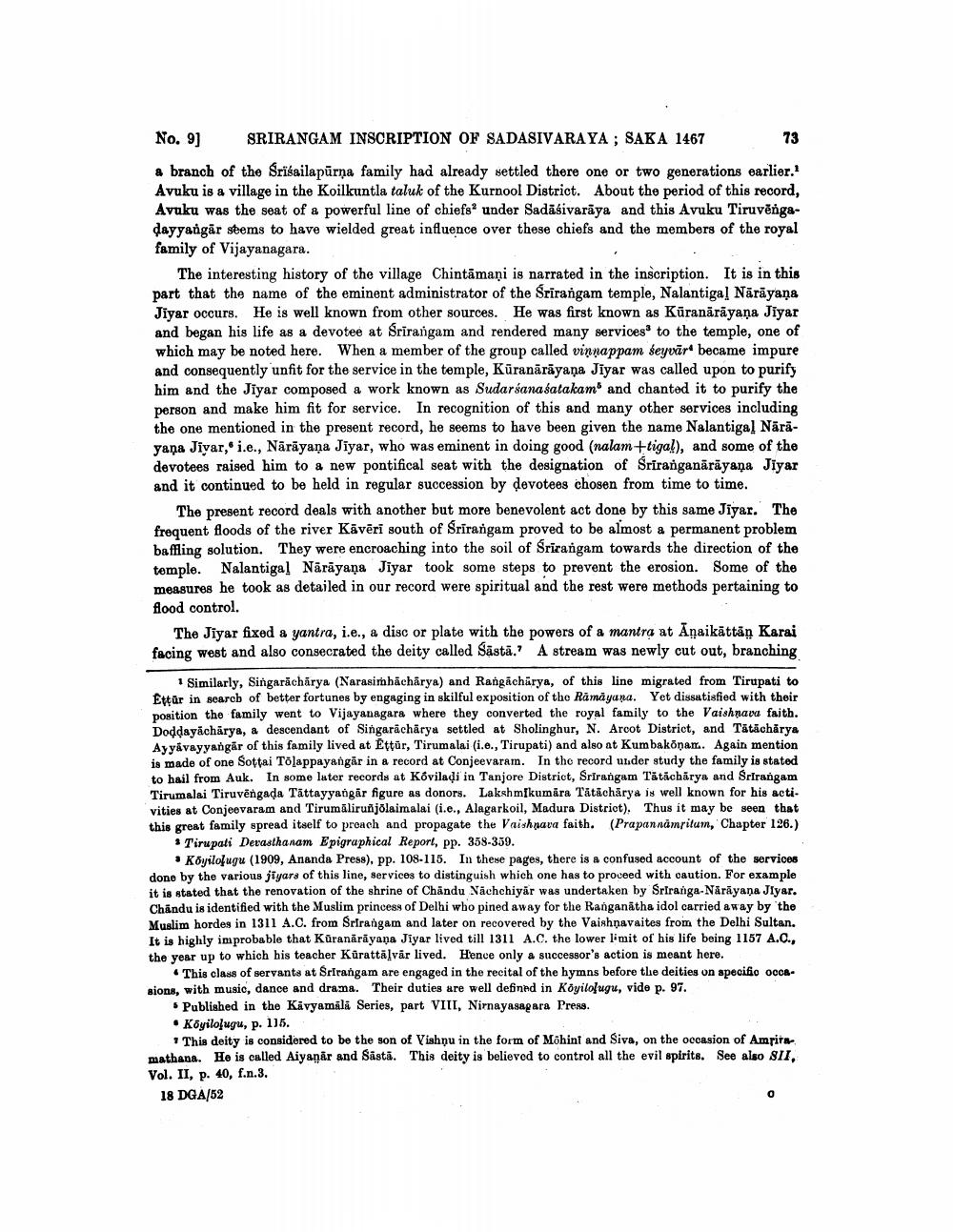________________
No. 9)
SRIRANGAM INSCRIPTION OF SADASIVARAYA ; SAKA 1467
13
a branch of the Srisailapürna family had already settled there one or two generations earlier.! Avuku is a village in the Koilkuntla taluk of the Kurnool District. About the period of this record, Avuku was the seat of a powerful line of chiefs under Sadāśivarāya and this Avuku Tiruvēngadayyangår stems to have wielded great influence over these chiefs and the members of the royal family of Vijayanagara.
The interesting history of the village Chintāmaņi is narrated in the inscription. It is in this part that the name of the eminent administrator of the Srirangam temple, Nalantigal Nārāyana Jiyar occurs. He is well known from other sources. He was first known as Kūranārāyaṇa Jiyar and began his life as a devotee at Srirangam and rendered many services to the temple, one of which may be noted here. When a member of the group called vinnappam seyvīre became impure and consequently unfit for the service in the temple, Kūranārāyaṇa Jiyar was called upon to purify him and the Jiyar composed a work known as Sudarsanaśatakam and chanted it to purify the person and make him fit for service. In recognition of this and many other services including the one mentioned in the present record, he seems to have been given the name Nalantigal Nārāyana Jiyar,' i.e., Nārāyana Jiyar, who was eminent in doing good (nalam+tigal), and some of the devotees raised him to a new pontifical seat with the designation of Sriranganārāyana Jiyar and it continued to be held in regular succession by devotees chosen from time to time.
The present record deals with another but more benevolent act done by this same Jiyar. The frequent floods of the river Kāvēri south of Srirangam proved to be almost a permanent problem baffling solution. They were encroaching into the soil of Srirangam towards the direction of the temple. Nalantigal Nārāyaṇa Jiyar took some steps to prevent the erosion. Some of the measures he took as detailed in our record were spiritual and the rest were methods pertaining to flood control.
The Jiyar fixed a yantra, i.e., a disc or plate with the powers of a mantra at Āņaikāttä Karai facing west and also consecrated the deity called Sāstā.? A stream was newly cut out, branching
1 Similarly, Singarācharya (Narasimhacharya) and Rangáchārya, of this line migrated from Tirupati to Ettär in search of better fortunes by engaging in skilful exposition of the Ramayana. Yet dissatisfied with their position the family went to Vijayanagara where they converted the royal family to the Vaishnavu faith. Doddayācharya, a descendant of Singaracharya settled at Sholinghur, N. Aroot District, and Tätācharya Ayyåvayyangår of this family lived at Ettur, Tirumalai (i.e., Tirupati) and also at Kumbakonan.. Again mention is made of one Sottai Tölappayangår in a record at Conjeevaram. In the record under study the family is stated to hail from Auk. In some lutor records at Koviladi in Tanjore Distriot, Srirangam Tatacharya and Srirangam Tirumalai Tiruvēngada Tattayyangär figure as donors. Lakshmikumara Tatacharya is well known for his acti. vities at Conjeevaram and Tirumälirunjolaimalai (i.e., Alagarkoil, Madura District), Thus it may be seen that this great family spread itself to proach and propagate the Vaishnava faith. (Prapan nämritum, Chapter 126.)
1 Tirupati Devasthanam Epigraphical Report, pp. 358-359.
• Köyilolugu (1909, Ananda Press), pp. 108-115. In these pages, there is a confused account of the services done by the various jiyars of this line, services to distinguish which one has to proveed with caution. For example it is stated that the renovation of the shrine of Chandu Nächchiyar was undertaken by Sriranga-Närāyana Jiyar. Chăndu is identified with the Muslim princess of Delhi who pined away for the Ranganātha idol carried away by the Muslim hordes in 1311 A.C. from Srirangam and later on recovered by the Vaishnavaites from the Delhi Sultan. It is highly improbable that Küranarayana Jiyar lived till 1311 A.C. the lower limit of his life being 1157 A..., the year up to which his teacher Kürattālvår lived. Hence only a successor's action is meant here.
* This class of servants at Srirangam are engaged in the recital of the hymns before the deities on specifio occasions, with music, dance and drama. Their duties are well definind in Koyilolugu, vide p. 97.
• Published in the Kivyamala Series, part VIII, Nirnayasagara Press • Köyilolugu, p. 115.
* This deity is considered to be the son of Vishnu in the form of Mohint and Siva, on the occasion of Amritamathapa. He is called Aiyanår and Sastā. This deity is believed to control all the evil spirits. See also II. Vol. II, p. 40, f.n.3.
18 DGA/52




